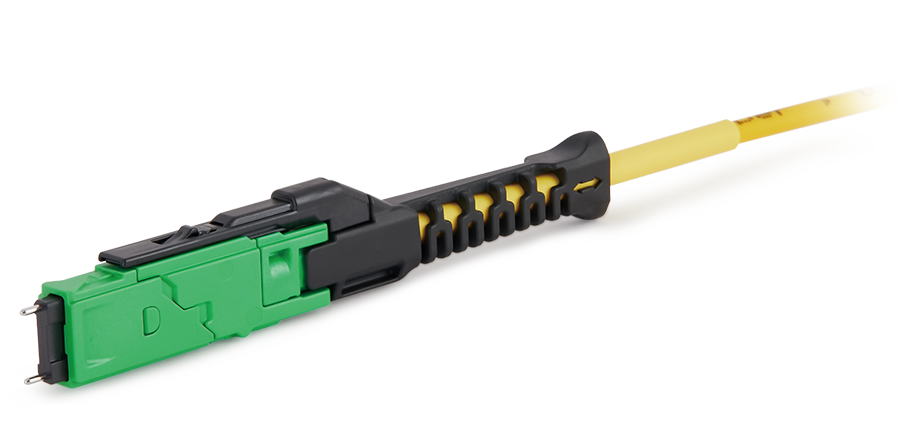In the passive optical network, the optical splitter plays an important role. It realizes the sharing of a passive optical fiber network by multiple end users. PLC splitters have good performance and are widely used in fiber optic networks.
Ⅰ. What is a PLC splitter?
PLC optical splitter, also known as the planar lightwave circuit splitter, is a passive device with multiple input ends and multiple outputs, which splits one or two input optical signals into two or multiple output optical signals. It is especially suitable for connecting central office equipment and terminal equipment in passive optical networks such as FTTX, EPON, GPON, and BPON to realize optical signal splitting. The advantages of fiber optic PLC splitter are as follows:
1. The light splitting is uniform and there are many branches, which can evenly distribute the optical signal to multiple end users, and the number of channels is up to 128;
2. The structure is compact and the volume is small, which can be installed without large space, and it is commonly seen in various transfer boxes;
3. The more branch channels there are, the more obvious the cost advantage there will be;
In short, the PLC splitter is a low-cost, high-stability and reliable solution with an optical splitting ratio of up to 1:128.
Ⅱ. The production process of the PLC splitter
The PLC optical splitter is produced based on planar optical waveguide technology. The PLC optical splitter is composed of a PLC splitter chip and multiple optical waveguide arrays (ie, input and output fiber arrays), and the fiber arrays are respectively coupled to both ends of the PLC splitter chip. That is to say, the two ends of the chip are respectively coupled to encapsulate the input end and the output end of the multi-channel optical fiber array. The function of branching is completed on the chip, and up to 128 branches can be realized on one chip.
Ⅲ. The classification of PLC splitter
PLC optical splitter can be classified into 1xN PLC optical splitter and 2xN PLC optical splitter, such as 1x4 PLC optical splitter, 1x8 PLC optical splitter, 1x16 PLC optical splitter, 2x32 PLC optical splitter, 2x64 PLC optical splitter, etc.
In addition, according to the different packaging types, PLC optical splitter is classified into bare fiber type PLC optical splitter, miniature steel tube type PLC optical splitter, ABS box type PLC optical splitter, tray-type PLC optical splitter, rack-type PLC optical splitter, LGX box optical splitter, and miniature plug-in PLC optical splitter, etc.
Ⅳ. The application of the PLC splitter
In passive optical networks, PLC splitters are usually installed between an Optical Line Terminal (OLT) and an Optical Network Unit (ONU) or Optical Network Terminal (ONT) near the end user. The input end of the PLC splitter is connected with the optical fiber link of the OLT in the central office (CO), and multiple optical signals are split and transmitted to the end users of the optical network.
The PLC optical splitter can realize optical signal splitting in two ways: centralized distribution and cascaded distribution. Centralized distribution means that the PLC optical splitter is centrally installed at a certain position between the optical line terminal (OLT) and the optical network unit (ONT), centrally performs optical splitting processing on the signal at the central office and then transmits it to each end user.
At this time, the central office often uses a 1x32 or 1x64 PLC optical splitter. Different from the centralized distribution, the PLC splitters in the cascade distribution are distributed more and scattered, and the structure is complex. In this structure, there is both primary and secondary splitting. Normally, a 1x4 PLC splitter (connected to the OLT port) is used for the first-level split, and a 1x8 PLC splitter (connected to an external terminal) is used for the second-level split.

 Fiber Optic Flex Circuit (FOFC)
Advanced Simulation & Optimization, High Positioning Accuracy, Flexible Customization, Rigorous Reliability Testing
Fiber Optic Flex Circuit (FOFC)
Advanced Simulation & Optimization, High Positioning Accuracy, Flexible Customization, Rigorous Reliability Testing MDC Solution
US Conec's MDC connector is a Very Small Form Factor (VSFF) duplex optical connector, expertly designed for terminating single-mode and multimode fiber cables with diameters up to 2.0mm.
MDC Solution
US Conec's MDC connector is a Very Small Form Factor (VSFF) duplex optical connector, expertly designed for terminating single-mode and multimode fiber cables with diameters up to 2.0mm. MMC Solution
US Conec's Very Small Form Factor (VSFF) multi-fiber optical connector that redefines high-density connectivity with its cutting-edge TMT ferrule technology and intuitive Direct-Conec™ push-pull boot design.
MMC Solution
US Conec's Very Small Form Factor (VSFF) multi-fiber optical connector that redefines high-density connectivity with its cutting-edge TMT ferrule technology and intuitive Direct-Conec™ push-pull boot design. EN
EN
 jp
jp  fr
fr  es
es  it
it  ru
ru  pt
pt  ar
ar  el
el  nl
nl 



_and_High-Reflection_(HR)_Optical_Coatings.webp)
